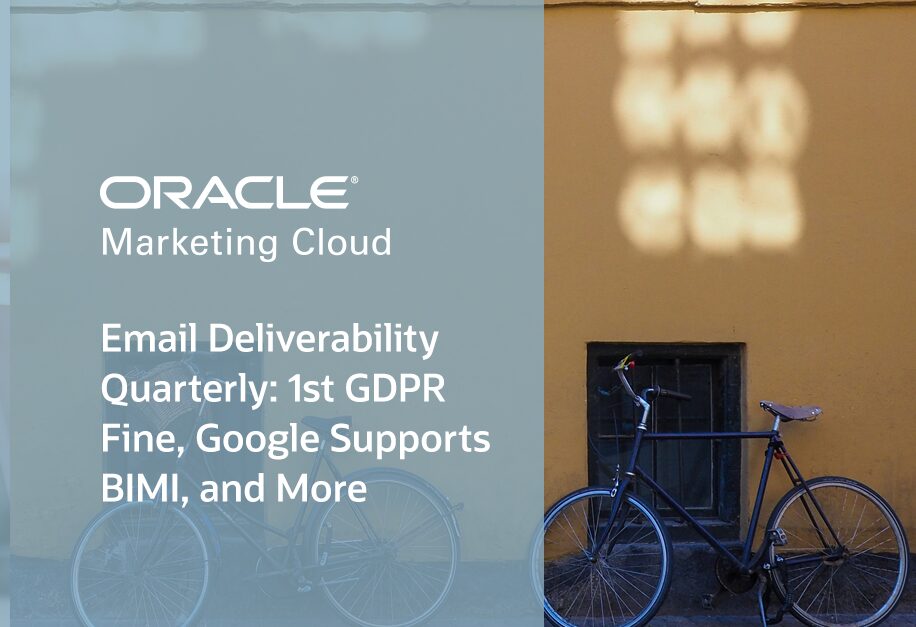
Email deliverability is constantly changing, as inbox providers adjust their filtering algorithms, blacklists tweak their listing criteria, and consumers evolve their definition of spam. That’s why even the best email marketing programs suffer deliverability problems sometimes.
To help you avoid trouble, the Email Deliverability Services team at Oracle Marketing Cloud (OMC) Consulting shares the latest news and tips for what to watch out for. Here’s what’s going on at key inbox providers and what it means for email marketers:
£183m GDPR Fine Levied against British Airways
In the first penalty levied since the General Data Protection Regulation (GDPR) went into effect, British Airways faces a record £183 million fine for a 2018 data breach that affected 500,000 customers. The fine is equal to 1.5% of British Airways’ worldwide revenue in 2017, which is less than half of the possible maximum fine of 4% of annual sales.
In announcing the fine, the Information Commissioner’s Office said that customers’ log in, payment card, travel booking, name, address, and other details were compromised by British Airways’ poor security.
What this means for marketers:
“GDPR enforcement has been slow to ramp-up, but with this high-profile penalty, it’s clear that the EU’s Information Commissioner’s Office will impose the stiffest penalties that the GDPR affords,” says Brian Sullivan, Strategy Director of Email Deliverability Services at OMC Consulting. “With this BA breach penalty, brands are on notice that GDPR compliance is critical and that breaches won’t be tolerated.”
Google Commits to BIMI Pilot
In July, Gmail owner Google announced that it joined the growing list of email technology companies that support Brand Indicators for Message Identification (BIMI). The standard, which is operated by AuthIndicators Working Group, helps responsible, legitimate senders increase their branding in the inbox by having their logo appear next to their sender name. Verizon Media began trialing BIMI in its Yahoo web and mobile email clients last year.
What this means for marketers:
“This is big news for B2C brands, since Gmail makes up the majority of their email lists,” says Clea Moore, Director of Deliverability Strategy at OMC Consulting. “The addition of Google to the BIMI program provides marketers with greater brand visibility.”
BIMI also promotes brand security by reducing opportunities for spoofing, says Moore. That’s achieved by requiring companies to enroll, have your logo certified by approved third parties, and having a Domain-based Message Authentication, Receiving & Conformance (DMARC) policy set to quarantine or reject.
Microsoft Evaluating AMP for Email in Outlook.com
Microsoft announced that it is evaluating AMP for Email as a preview. AMP support is currently turned off by default, but users of the Outlook.com web email client can turn it on to test out how AMP-power emails behave in their inbox.
What this means for marketers:
AMP for Email has its pros and cons, but having the standard more broadly supported would definitely be a plus. It would mean that the additional development time that AMP for Email requires would be offset by having a higher percentage of a brand’s subscriber base experiencing the more interactive and up-to-date emails it allows.
A successful evaluation would mean the enablement of AMP for Email by default in Outlook.com, and would likely lead to Microsoft evaluating the standard in its other email clients.
Gmail Enables Image Blocking to Thwart Tracking
Google has added a toggle to the iOS Gmail app that allows users to turn off the automatic loading of images in their Gmail inbox. “This is primarily a privacy feature,” says Sullivan. “It gives users control over tracking pixels, which are essentially tiny, invisible image files that load along with visible images in message content. When the message is opened, tracking pixels report data back to the sender about the user, such as when the message was opened and sometimes location.”
What this means for marketers:
We don’t expect to see a major impact from this change because it requires users to take action. “The user must access the settings and select to be asked if images should be loaded for each message they receive,” says Sullivan. “Most users will continue to allow images to load automatically out of convenience, while only the most privacy-minded users will turn off automatic loading. The overall impact may be a slight downward shift in open rates across your iOS audience.”
Cox Not Allowing New Email Addresses
Cox Communications announced that it wouldn’t allow its customers to create new Cox Email accounts as of August 15, 2019, but would continue to support existing ones. As part of its broadband packages, Cox has long offered Cox.net email addresses to its customers, but they said that “in recent years, fewer customers have taken advantage of a Cox Email account.”
OMCC’s Sullivan says, “While many Cox customers have used those provided inboxes, a small percentage use them as their primary email inboxes. Most consumers these days are opting for primary email addresses at one of the top free inbox providers—Gmail, Outlook.com, Yahoo, or AOL—because it’s a permanent email address you can take with you anywhere you access the internet.”
What this means for marketers:
“Marketers should expect list share at the cox.net domain to stagnate in the near term and then to decline steadily over time,” says Sullivan. “Active and engaging email addresses at the cox.net domain are a sign of customers that are using the domain as their primary email inbox, so continue to optimize delivery to the domain to serve those customers, despite the domain’s waning presence.”
—————
Need help with your email deliverability? Oracle Marketing Cloud Consulting has more than 500 of the leading marketing minds ready to help you to achieve more with the leading marketing cloud, including a dedicated email deliverability practice within our Strategic Services Group.
